What’s for breakfast?
Banitsa is a Bulgarian breakfast staple. The flaky pastry parcels are filled with sirene cheese (similar to Greek feta). One of the best places to try one is at Bakeland, on the edge of the Kapana and Old Town districts. It also makes delicious handmade cakes and sweets, with a few gluten-free options.
Night at the opera

The Ancient Theatre is Plovdiv’s most famous cultural landmark: a Roman amphitheatre in a dramatic position on a hill above the city. Visitors can enjoy performances by the Plovdiv Opera and its international guests while sitting on ancient marble seats looking over the whole city centre, with the Rhodope mountains in the distance – a breathtaking spectacle.
bulgariatravel.org
Creative district
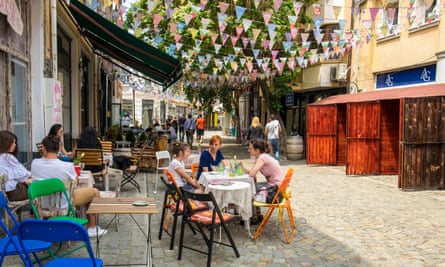
Kapana is now the creative heart of the city, a pedestrianised area full of shops, restaurants and galleries. In the 1990s it was a parking zone full of ruined houses. The transformation began in 2014, when 10 creative enterprises moved into the area, funded by the European Capital of Culture Foundation, and things have taken off from there. The best place to enjoy the city’s art scene is a space called Cu29. It combines a cafe and gallery and was established by artist Velizar Dimchev to promote emerging talent from Plovdiv. Afterwards grab a drink at Kapana’s coolest cocktail bar, Ginger Tale.
Art and bath

Very often cultural experiences in Plovdiv are an interesting mix of contemporary art and centuries-old architectural and cultural monuments. Established in 1995, the Ancient Bath was run by an independent art association for more than 20 years. The interior of the 16th-century Turkish bath is still intact, so art pieces are set in an authentic atmosphere with original stone walls and a stunning central dome. Currently the space is managed by the City Gallery and is the main venue for contemporary art exhibitions. It’s especially pleasant during the summer months and early September, when it remains cool in the Plovdiv heat.
plovdiv2019.eu
Ottoman-era houses

Hilly Plovdiv old town is famed for its photogenic winding cobbled streets and beautifully preserved Ottoman-era townhouses. One of the most splendid is the Hindliyan House, whose Armenian merchant owner installed a rose-water fountain in the hayet, or main living space. This has recently been restored to its former, fragrant glory – the smell fills the room. Another favourite is Klianti House, which has beautifully painted ceilings and half-size rooms with tiny doors that were once used for storing the merchant’s wares. It feels like you have entered floor 7½ in Being John Malkovich.
Entry to each house 5 Lev (£2.29). A £7 ticket gives entry to five Old Town locations
Drink Thracian wine
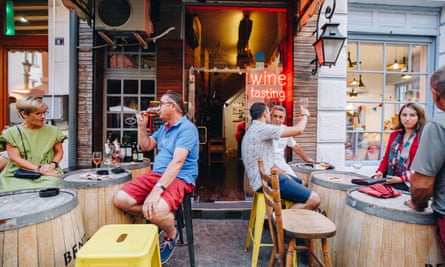
The dusty plain on which Plovdiv is built has a perfect climate for growing grapes, particularly red varieties, such as the rich, dark mavrud (apparently, it has been grown here since Thracian times). Bulgaria Wine Tours organises wine-tasting trips from a half-day to a week (from €80 for a half-day, reductions for groups of over three). Local vineyards of note include Dragomir, Villa Yustine and the organic Zagreus. If you don’t have time for a wine-tasting trip, another top producer, Bendida, has a bar and shop in the pedestrianised Kapana district. It’s run by the third generation of the Portev family, who have a vineyard a few miles outside the city in the foothills of the Rhodope mountains. The family tradition is in safe hands: daughter Elizabet is already producing award-winning rosés.
Hot takes on old dishes

Food is another of Plovdiv’s strengths, and a new generation of restaurateurs are using local ingredients to turn out modern takes on traditional Bulgarian food. The hottest place in town is Pavaj (mains from £6). Its young owners, Raycho Markov and Madlen Pakratyan, are obsessive about their trade, from growing rare heritage tomatoes in Markov’s father’s garden in the mountains to travelling the Balkans in search of great rakia (fruit brandy). Ask nicely and they may offer you samples from the restaurant’s impressive collection. The food is simple and seasonal, from salads and meatballs to grilled sheep’s cheese and bread made to Raycho’s grandmother’s recipe. The pillow-soft rolls are cut in half, fried in clarified butter and sprinkled with a salt and spice mix. It may just be the most addictive thing you try in Bulgaria. Be sure to book ahead. Another good option is the recently opened Aylyakriya, (Kozhukarska 3), also in Kapana, that does smart takes on traditional dishes, such as kačamak (polenta), pork ribs and beans and an exceptional strawberry cheesecake (mains from around £6).
Restaurant with a view
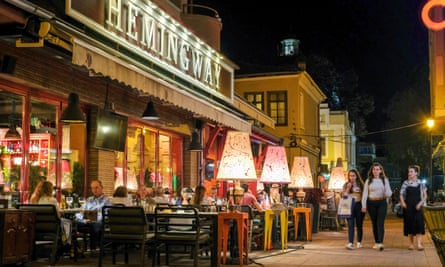
On the edge of the old town and overlooking the Kapana district, the shady terrace of Restaurant Philoppopolis (mains from about £12) has one of the best views in the city (Philoppopolis was the ancient name for Plovdiv). The interior is in 1920s Viennese style and there is a gallery and museum in the same building. It’s the most romantic place to eat in Plovdiv. A classy option in the centre of town is Hemingway Restaurant, which serves sophisticated Bulgarian and European dishes (mains from £7).
Buy local crafts
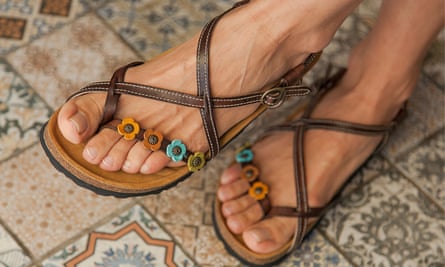
Magura Street in Kapana is full of shops selling local crafts and souvenirs. There are places to buy handmade belts with ornate buckles and the pagan kukere masks worn by Bulgarians to scare off evil spirits during midwinter celebrations. Piuma D’oro has beautiful sandals, leather bags and jewellery designed and handmade by its owner, Polina Kozarova. She worked as a shoe designer for 23 years before opening her own shop three years ago. For me this sums up the story of Kapana: it provides spaces for people to pursue their craft and sell what they make directly to customers. In the old town, the Street of Crafts, Stramna, is another place to buy local wares and see artisans at work in their studios.
Climb the city hills

Plovdiv was built on seven hills. There are actually only six now: one was quarried for materials to construct the city centuries ago. The most popular for tourists is Nebet Tepe, one of the three hills of the Old Town. The earliest archaeological remains date from 4,000BC (Plovdiv claims to be the oldest continually inhabited city in Europe). But Bunardzhik Tepe, also known as Alyosha Hill, with its huge Soviet soldier statue looming at the summit, is particularly special. The view from the top is superb and it’s often a setting for open-air parties.
Getting there Plovdiv is a 2.5-hour bus ride from Sofia.
Stay Hotel Evmolpia (doubles from £44 B&B) is a new boutique hotel in the Old Town. The newly renovated Stay Hotel (doubles from £45 B&B) is in the city centre, just off Central Square.

Best time to visit Spring and autumn are particularly lovely in Plovdiv. The city gets hot in July and August (average highs of 30C), but the city stays alive with festivals. This year there is a full programme of cultural events for the European Capital of Culture celebrations. Winters are cold (average highs between -2C and 7C), and snow is not uncommon. It’s fairly dry, with only 127mm of precipitation a year (London has 590mm, Manchester 930mm). In late September the city hosts trade fairs that push rates higher (2019: 23-28 September).
Prices Beer (half litre) £1, cappuccino £1.10, three-course meal for two £18.50.
Svetlana Kuyumdzhieva is artistic director of Plovdiv European Capital of Culture 2019, and Rumyana Tolova, is a PR professional in the city. Both were born in and are residents of Plovdiv
Looking for a holiday with a difference? Browse Guardian Holidays to see a range of fantastic trips
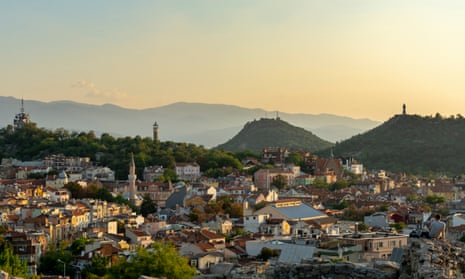
Comments (…)
Sign in or create your Guardian account to join the discussion